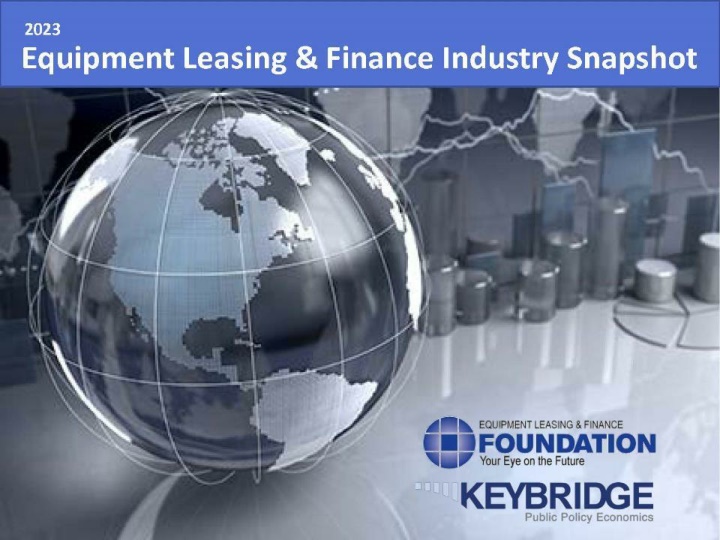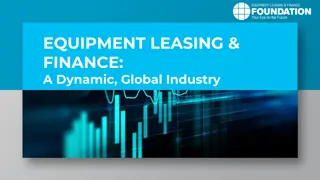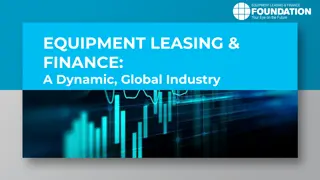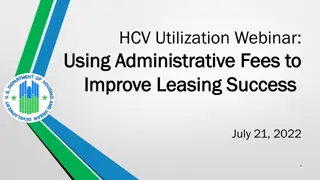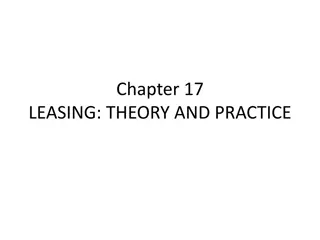Equipment Leasing and Finance Industry Overview December 2022
Snapshot of the Equipment Leasing and Finance Industry and U.S. Economy in December 2022. Explore the latest economic trends, job market insights, legislative impacts, and global economic headwinds and tailwinds shaping the industry landscape. Gain valuable insights into GDP growth, investment patterns, and business health indicators.
Download Presentation

Please find below an Image/Link to download the presentation.
The content on the website is provided AS IS for your information and personal use only. It may not be sold, licensed, or shared on other websites without obtaining consent from the author.If you encounter any issues during the download, it is possible that the publisher has removed the file from their server.
You are allowed to download the files provided on this website for personal or commercial use, subject to the condition that they are used lawfully. All files are the property of their respective owners.
The content on the website is provided AS IS for your information and personal use only. It may not be sold, licensed, or shared on other websites without obtaining consent from the author.
E N D
Presentation Transcript
Snapshot of the Equipment Leasing and Finance Industry and U.S. Economy December 2022 Prepared For: Equipment Leasing & Finance Foundation Prepared By: Keybridge LLC
Data: Table of Contents 1. Overall Economy p. 3 2. Investment p. 8 3. Business Health p. 11 2
Economy The economy expanded in Q3 2022 following two consecutive quarters of decline, growing 2.9% (SAAR), largely due to robust net exports. Real GDP Growth Annualized % Change from Prior Quarter 10% Forecast 30-Year Quarterly Average = 2.6% +2.9% 7.0% 35.3% 7.0% 6.3% 5% 3.9% 3.6% 3.0% 2.7% 2.7% 1.0% 2.2% +0.7% 1.8% 0% -0.4%-0.8%-1.0% -0.6% -1.6% -4.6% -29.9% -5% -10% 2018.Q4 2019.Q4 2020.Q4 2021.Q4 2022.Q4 2022.Q4 3 Source: U.S. Bureau of Economic Analysis, Keybridge LLC
Economy The Q3 expansion was driven by a large increase in net exports and strong consumer spending, which offset a decline in business investment. Tailwinds & Headwinds Contributions to GDP growth by sector HEADWINDS [-2.54] TAILWINDS [+5.47] Government Spending +0.53 +0.83 E&S Investment -2.54 Other Investment +1.18 Consumer Spending GDP CHANGE [+2.93] +2.93 Net Exports 4 Source: U.S. Bureau of Economic Analysis, Keybridge LLC
Top Economic Tailwinds ECONOMIC TAILWINDS The economy added 261k jobs in November and job openings remain well above pre-pandemic levels. However, recent signs that wage growth may be accelerating could be a concern for the inflation outlook. Ongoing Fed rate hikes will likely take steam out of the labor market. Strong Labor Market The pandemic fundamentally altered global supply chains, forcing many businesses to re-consider how far their supply chains stretch. Indeed, a 2022 Deloitte survey reported that 2/3 of surveyed manufacturers intend to shift capacity to the U.S. or are considering it, and nearly 1/4 of their Asia-originating freight is expected to shift to the Americas by 2025. Post-COVID Supply Chain Shifts Congress managed to pass three major bills over the past year: the Infrastructure Investment and Jobs Act (IIJA), the CHIPS and Science Act (CHIPS), and the Inflation Reduction Act (IRA). Totaling at least $600 billion in new spending, these bills are expected to act as a catalyst in spurring growth within the manufacturing sector and building greater supply resiliency on domestic soil. Pro-Industrial Legislative Boost 5 Source: 2023 Annual Equipment Leasing & Finance U.S. Economic Outlook
Top Economic Headwinds ECONOMIC HEADWINDS Global growth is expected to slow drastically in 2023 as a result of geopolitical turmoil, rising interest rates, and a slowing Chinese economy. However, the IMF predicts advanced countries, particularly those facing energy shortages, will experience the largest slowdowns while many developing nations will be somewhat more insulated. Global Economic Slowdown In the latter half of 2022, home prices declined at their fastest rate since the housing market collapse that led to the Great Recession. Indeed, sharply rising interest rates have dampened demand for housing and led to price drops, plummeting homebuilder sentiment, and record declines in mortgage applications. Sharply Slowing Housing Sector The U.S. Treasury market has experienced several brief drops in liquidity as it has been roiled by rate hikes and concerns about the strength of the U.S. economy. While liquidity concerns have not yet led to fallout elsewhere, some economists worry that the Treasury market could break at a time of heightened volatility and spur broader financial market contagion. Financial Market Turmoil 6 Source: 2023 Annual Equipment Leasing & Finance U.S. Economic Outlook
Special Topic SPECIAL TOPIC: Recession Watch Keybridge Recession Monitor Red = recession, green = no recession, yellow = in between Recession Gauge Number of indicators flashing red Indicator Lead Value 12 36 months 12 24 months 6 18 months 6 12 months 6 12 months 6 12 months 6 12 months 1 6 months 0 6 months Recession Watch Consumer Expectations Present Situation Spread 1 -62 Yield Curve (10-year / 2-year spread) -72 bp 5 Recession Warning NAHB Housing Market Index -60% 4 6 7 3 Leading Economic Index 2 -2.7% Advisory 8 2 NFIB Capex Index -26% 1 9 C&I Loan Delinquency Rate 7.0 pp LowRisk Elkhart, Indiana Employment 3 1.2% 0 10 Capacity Utilization -0.18% Consumer Confidence/ Unemployment Rate 15% Household Durable Purchasing Sentiment Index3 Concurrent -14% 7 Source: 2023 Annual Equipment Leasing & Finance U.S. Economic Outlook
Projections for Key Economic Indicators 2023 Quarterly Estimates Indicator 2021 2022 2023e Q1e Q2e Q3e Q4e 1.0% -0.4% -0.8% -1.0% Real GDP(SAAR %) 5.9% 2.0% 0.9% Real Investment in Equipment & Software(SAAR %) 5.0% 1.0% -1.9% -2.8% 11.1% 7.2% 4.2% 6.0% 5.0% 4.4% 3.7% Inflation (year-on-year %) 4.7% 8.1% 4.8% Federal Funds Target Rate (upper bound, end of period) 5.50% 5.50% 5.00% 4.25% 0.25% 4.50% 4.25% 500 210 75 -10 Total Payroll Growth (thousands) 6,743 4,508 775 Source: 2023 Annual Equipment Leasing & Finance U.S. Economic Outlook 7
Investment After being flat in Q2, business investment rose at a 5.1% annualized pace thanks to strong equipment investment growth in Q3. Business Investment Real Nonresidential Fixed Investment, % Change from Prior Quarter 20% 5.1% 10% 0% -29.4% -10% -20% Q3.2012 Q3.2013 Q3.2014 Q3.2015 Q3.2016 Q3.2017 Q3.2018 Q3.2019 Q3.2020 Q3.2021 Q3.2022 Source: U.S. Bureau of Economic Analysis 8
Investment While several sectors are continuing to expand despite rising interest rates, growth has begun to slow for most. Equipment & Software Investment Momentum Monitor (Equipment Vertical Performance Matrix) Source: 2022 Q4 Equipment Leasing & Finance U.S. Economic Outlook For more information on how to use the Momentum Monitors, see final slide. 9
Investment E&S investment growth is forecasted to slow in 2023 as the Fed s rate hikes start to slow economic growth and cool businesses investment. Real Equipment & Software Investment Growth Q/Q % change, SAAR 20% Forecast 17.5% 12.0% 13.8% 13.7% 40.1% 11.7% 10% 8.0% 5.0% 2.6% 2.4% 1.9% 1.5% 1.1% 1.0% 0.7% 0% -14.0% -28.3% -1.8% -1.9% -2.8% -2.9% -10% 2018.Q4 2019.Q2 2019.Q4 2020.Q2 2020.Q4 2021.Q2 2021.Q4 2022.Q2 2022.Q4 2023.Q2 2023.Q4 Source: U.S. Bureau of Economic Analysis; Projections from Keybridge 10
Bus. Health New business volume was up 5.8% year-to-date in October. MLFI-25 New Business Volume Billions of $ $140 $120 $117.4 $111.1 $108.5 $100 $103.6 $102.1 $99.5 $97.4 $96.7 $95.1 $89.0 $80 $84.6 $74.0 $60 $60.6 $54.3 $40 $20 $0 2009 2010 2011 2012 2013 2014 2015 2016 2017 2018 2019 2020 2021 2022 Source: ELFA MLFI-25 *Note: The MLFI-25 reports economic activity from 25 companies representing a cross section of the equipment finance sector. It does not represent the total size of the equipment finance industry. 11
Bus. Health Nominal new business volume growth has been solid most of 2022. However, high inflation continues to cut into real NBV. MLFI-25 New Business Volume (NBV) Y/Y % change 30% 20% 6% 10% 0% -10% New business volume is up 5.8% year-to-date -20% -30% May 17 May 18 May 19 May 20 May 21 May 22 Source: ELFA MLFI-25 *Note: The MLFI-25 reports economic activity from 25 companies representing a cross section of the equipment finance sector. It does not represent the total size of the equipment finance industry. 11
Bus. Health Equipment finance industry confidence has followed a downward path since its peak in early 2021. It is at its lowest level since May 2020. Monthly Confidence Index: Equipment Finance Industry (MCI-EFI) 80 70 60 50 40 43.7 30 20 Nov 13 Nov 14 Nov 15 Nov 16 Nov 17 Nov 18 Nov 19 Nov 20 Nov 21 Nov 22 Source: ELFF MCI-EFI 13
Bus. Health The Equifax Small Business Lending Index fell 10.7 points in October, though the three-month moving average was above its year-ago level. Equifax Small Business Lending Index (SBLI) January 2005 = 100 170 SBLI 145 142.2 SBLI 3MMA 120 95 70 2012 2013 2014 2015 2016 2017 2018 2019 2020 2021 2022 Source: Equifax 14
EQUIPMENT LEASING & FINANCE FOUNDATION The latest edition of the Keybridge / Foundation U.S. Economic Outlook is available here at the Foundation s website. Reports are available to download at www.store.leasefoundation.org 15
EQUIPMENT LEASING & FINANCE FOUNDATION For more information, download the Applied Economics Handbook or research articles (2018 & 2022) analyzing the effect of inflation and rising interest rates on the equipment finance industry. 15
Notes *U.S. Equipment & Software Investment Momentum Monitor (Slide 10) Published monthly, the U.S. Equipment & Software Investment Momentum Monitor is a set of leading indicators for the equipment sector consisting of indices for various equipment and software investment verticals. These indices are designed to identify turning points in their respective investment cycles with a ~6-month lead time. Each index is comprised of between 15 to 20 high-frequency indicators and is statistically optimized to signal turning points in the investment cycle without giving false readings of shifts in momentum. The Momentum Monitor covers 12 equipment and software verticals as defined by the U.S. Department of Commerce Bureau of Economic Analysis. These verticals include aircraft, agriculture machinery, computers, construction machinery, materials handling equipment, medical equipment, mining and oilfield equipment, other industrial equipment, railroad equipment, ships and boats, software, and trucks. Recent Momentum" represents the degree of an indicator's recent acceleration or deceleration in the past month relative to its average movement during the previous 3 months. Ratings closer to "0" represent an indicator that is rapidly decelerating, while ratings closer to 10 represent an indicator that is rapidly accelerating. "Historical Strength" represents the strength or weakness of an indicator in the past month relative to its typical level since 1999. Ratings closer to "0" represent an indicator that is weaker than average, while ratings closer to "10" represent an indicator that is stronger than average. 16
